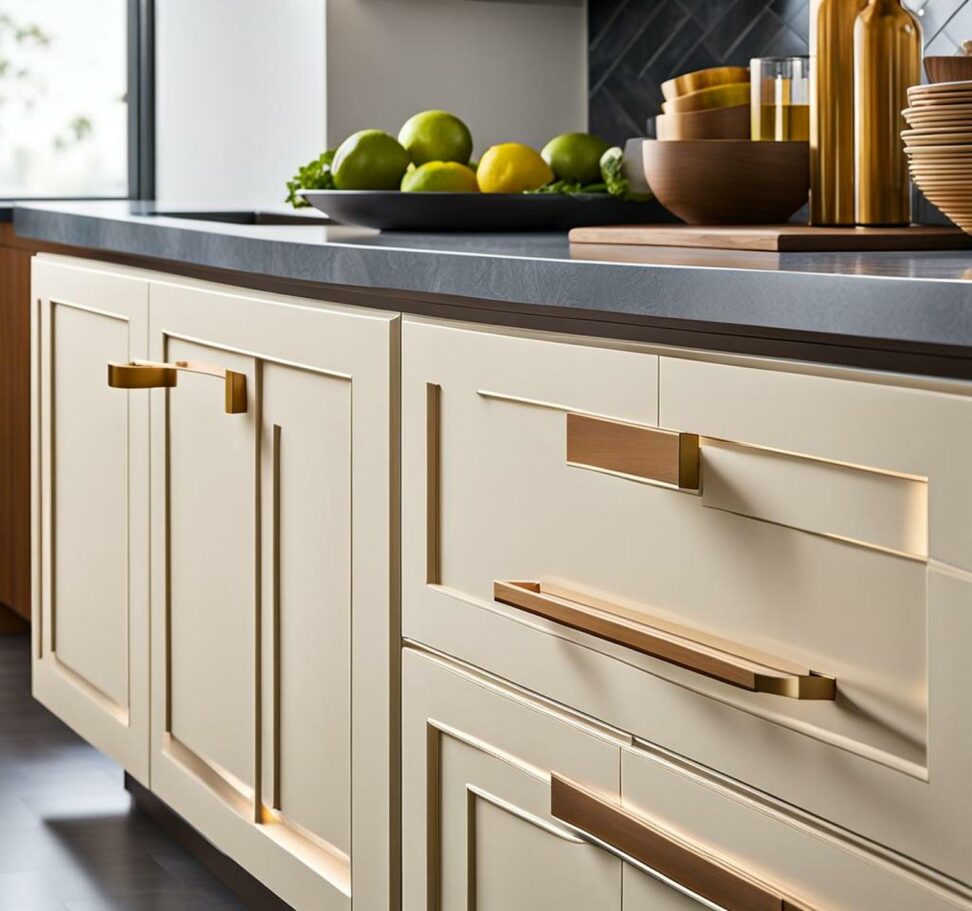The Complete Guide to Placing Handles on Kitchen Cabinets
Where you place hardware on kitchen cabinets makes a big difference, both visually and functionally. Proper placement allows cabinets to open and close cleanly while creating a cohesive, stylish look. You’ll learn general rules of thumb as well as adjustments based on cabinet type and door style.
Knowing where to put cabinet hardware might seem tricky. But following a few standard guidelines will set your kitchen up for success. Read on to get the complete rundown on placing handles and pulls on any type of kitchen cabinet!
Upper Cabinet Hardware Placement
Height Guidelines
On upper cabinets, the standard recommendation is to position knobs or pulls around 2-3 inches down from the top of the door. Placing them higher up makes sense ergonomically since upper cabinets are less frequently accessed.

Guidelines typically suggest 1-2 inches specifically. But anything in the 2-3 inch range often works well. Going higher than 3 inches starts to look a bit awkward.
Distance from Sides
For distance from the sides, general guidelines call for placing upper cabinet hardware around an inch from each side. Though anywhere from 3/4 inch to 1 1/2 inches is common.
Putting hardware too close to the edges can look crammed. But too far from the sides leaves visual gaps. The 1 inch midpoint nicely balances form and function.
On more ornate cabinet doors, increasing the distance slightly creates better proportions. For glass-front uppers, pull location also depends on hardware clearance behind the glass.
Lower Cabinet Hardware Placement
Height Guidelines
On lower cabinets, standard placement is around 1 inch up from the bottom of the door. This puts handles near the bottom edge, ideal for easy access.
Anywhere between 3/4 inch and 1 1/2 inches high typically works. Less than 3/4 inch starts to look visually unbalanced. Go higher than 1 1/2 inches only if required by specific users.
Distance from Sides
For lower cabinets, follow the same side spacing guidelines as uppers. Position handles about 1 inch from door sides for best proportions.
The distance ranges anywhere from 3/4 to 1 1/2 inches. Wider or narrower spacing can throw things off visually.
Drawer Hardware Position
Drawer pulls typically mount centered vertically on the drawer front. Or aligned with the horizontal cabinet handles above.
Feel free to offset pulls slightly if needed for clearance. Just maintain even spacing for visual consistency.
Door Hardware Orientation
Placing Hardware Opposite Hinges
Always install door hardware on the opposite side from the hinges. This allows full clearance when opening and closing.
Mounting pulls right next to hinges leads to hardware crashing into cabinet faces. Not functional or visually appealing.
Horizontal vs Vertical Orientation
Cabinet doors tend to get horizontal hardware while drawers often use vertical pulls. But focus first on consistency across each cabinet run.
Mixing things up can add appealing asymmetry. Just be intentional about placement to avoid a haphazard look.
Specialty Cabinet Considerations
Appliance Garages
On taller appliance garage doors, place hardware around 36-42 inches high. This puts handles at a comfortable, easy to reach height for most users.
For width, use the same general guidelines as standard cabinets. Position 1 inch from sides for well-balanced proportions.
Pantries
For walk-in pantries, put handles about 48 inches high if adults are the main users. Adjust up or down for other ages.
Maintaining 1 inch side margins creates a consistent look across your kitchen’s cabinets and drawers.
Proper cabinet hardware placement comes down to a few key guidelines. Keep handles around 2-3 inches from the top on upper cabinets. Put them around 1 inch from the bottom on lower cabinets. Maintain even side margins of around 1 inch.
Place pulls on the opposite side from hinges for full clearance. And opt for horizontal on doors, vertical on drawers. Following these simple tricks results in cabinets that look cohesive and perform flawlessly!